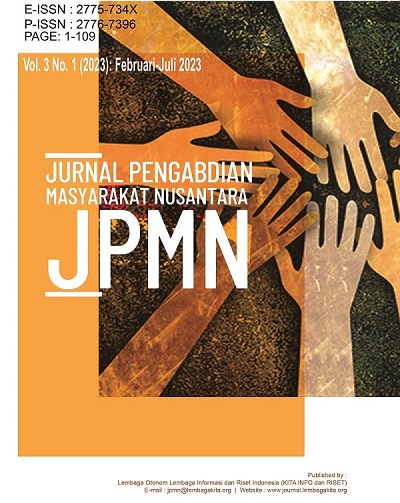Published: 2023-02-01
Peningkatan Layanan Kesehatan Karyawan Melalui Sistem Informasi Perlindungan, Pelacakan, dan Pengawasan Covid-19
DOI: 10.35870/jpmn.v3i1.832
Rosalina, Genta Sahuri, Simplisius Leandro Okhotan
Article Metrics
- Views 0
- Downloads 0
- Scopus Citations
- Google Scholar
- Crossref Citations
- Semantic Scholar
- DataCite Metrics
-
If the link doesn't work, copy the DOI or article title for manual search (API Maintenance).
Abstract
During the pandemic, PT. Trendology Indonesia applies the WFH system and implements a work shift system to reduce workplace density. Office and factory space occupancy quotas have been set to limit density and physical contact. PT. Trenologi Indonesia also provides health support to all of its employees by providing medicines or supporting vitamins, routine SWAB Antigen/PCR checks, sharing information regarding locations of vaccination points, and supporting other health systems during the COVID-19 pandemic. In addition, the Human Resources Division must also check employee attendance and employee positions during working hours. However, the process is still carried out by the Human Resources Division manually which causes delays and obstacles. To check and monitor the health conditions of workers so that they can optimally complete their work, one solution is to provide a website that has important features that can be accessed by all workers. So, from the results of this dedication, it will make it easier for the Human Resources (HR) team at partners to collect data for information related to COVID-19 such as vaccination data, health data data, and other information, besides that this system also helps HRD in tracking and monitoring health conditions employees
Keywords
Employee healthcare services ; Monitoring information system ; Pandemic covid-19
Article Metadata
Peer Review Process
This article has undergone a double-blind peer review process to ensure quality and impartiality.
Indexing Information
Discover where this journal is indexed at our indexing page to understand its reach and credibility.
Open Science Badges
This journal supports transparency in research and encourages authors to meet criteria for Open Science Badges by sharing data, materials, or preregistered studies.
How to Cite
Article Information
This article has been peer-reviewed and published in the Jurnal Pengabdian Masyarakat Nusantara (JPMN). The content is available under the terms of the Creative Commons Attribution 4.0 International License.
-
Issue: Vol. 3 No. 1 (2023)
-
Section: Articles
-
Published: %750 %e, %2023
-
License: CC BY 4.0
-
Copyright: © 2023 Authors
-
DOI: 10.35870/jpmn.v3i1.832
AI Research Hub
This article is indexed and available through various AI-powered research tools and citation platforms. Our AI Research Hub ensures that scholarly work is discoverable, accessible, and easily integrated into the global research ecosystem. By leveraging artificial intelligence for indexing, recommendation, and citation analysis, we enhance the visibility and impact of published research.




-
-
Liu, W., Tao, Z. W., Wang, L., Yuan, M. L., Liu, K., Zhou, L., Ming, Y. “Analysis of factors associated with disease outcomes in hospitalized patients with 2019 novel coronavirus disease”. Chinese medical journal. (2020): 2020 May 5;133(9):1032-1038. doi: 10.1097/CM9.0000000000000775. PMID: 32118640; PMCID: PMC7147279.
-
-
Yoshimoto T.; Fujii T.; Oka H.; Kasahara S.; Kawamata K.; Matsudaira K., Pain Status and Its Association with Physical Activity, Psychological Stress, and Telework among Japanese Workers with Pain during the COVID-19 Pandemic, International Journal of Environmental Research and Public Health, (2021): vol. 18, no. 11, pp. 1–10.

This work is licensed under a Creative Commons Attribution-NonCommercial-NoDerivatives 4.0 International License.
Authors who publish with this journal agree to the following terms:
1. Copyright Retention and Open Access License
Authors retain copyright of their work and grant the journal non-exclusive right of first publication under the Creative Commons Attribution 4.0 International License (CC BY 4.0).
This license allows unrestricted use, distribution, and reproduction in any medium, provided the original work is properly cited.
2. Rights Granted Under CC BY 4.0
Under this license, readers are free to:
- Share — copy and redistribute the material in any medium or format
- Adapt — remix, transform, and build upon the material for any purpose, including commercial use
- No additional restrictions — the licensor cannot revoke these freedoms as long as license terms are followed
3. Attribution Requirements
All uses must include:
- Proper citation of the original work
- Link to the Creative Commons license
- Indication if changes were made to the original work
- No suggestion that the licensor endorses the user or their use
4. Additional Distribution Rights
Authors may:
- Deposit the published version in institutional repositories
- Share through academic social networks
- Include in books, monographs, or other publications
- Post on personal or institutional websites
Requirement: All additional distributions must maintain the CC BY 4.0 license and proper attribution.
5. Self-Archiving and Pre-Print Sharing
Authors are encouraged to:
- Share pre-prints and post-prints online
- Deposit in subject-specific repositories (e.g., arXiv, bioRxiv)
- Engage in scholarly communication throughout the publication process
6. Open Access Commitment
This journal provides immediate open access to all content, supporting the global exchange of knowledge without financial, legal, or technical barriers.
